This post details the pros and cons of fiberglass hightop vans. This category includes a wide variety of vans, like handicap accessible vans, ambulances, conversion vans, or any other van with an aftermarket fiberglass high-top.

In the US, this is most often found on the common “work” vans, like Ford E-series, Chevy Express, GMC Savana, and the Dodge Ram Van. But these automakers only produce these vehicles with low-roofs, so someone has to modify the vehicle after to add an aftermarket fiberglass hightop.
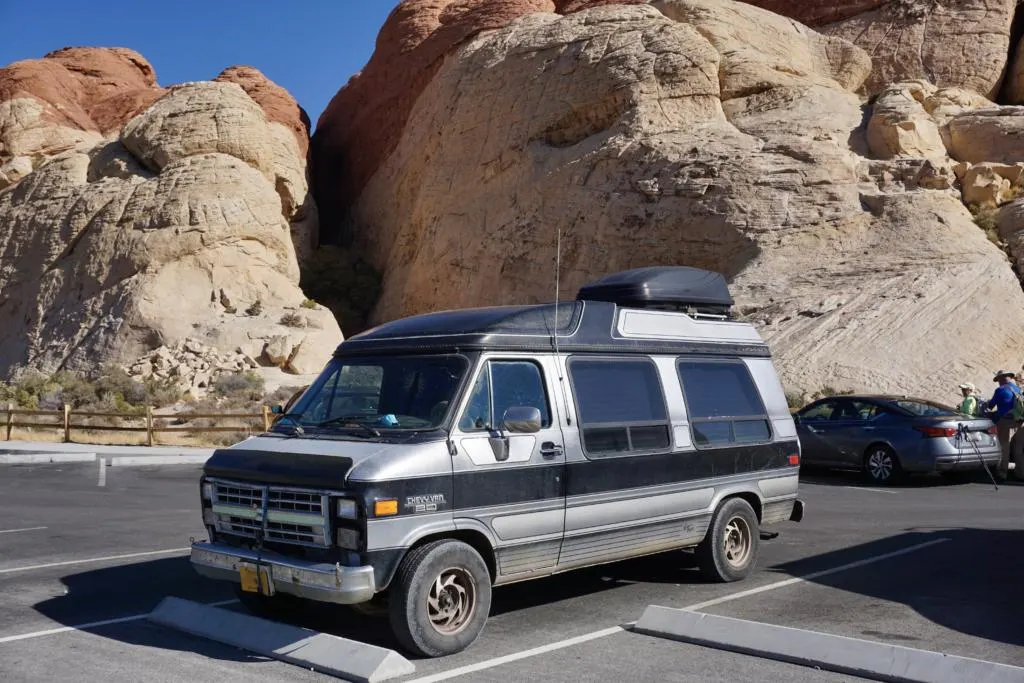
Without a doubt, the primary benefit of these vans is that they can offer a “standing-height” van that’s more affordable than euro-style vans like the Mercedes Sprinter, Ford Transit, and Ram Promaster. This makes using a fiberglass high-top van for a campervan conversion especially attractive to those on a budget. It’s specifically how Emily and I ended up buying one for our first van conversion.

But it’s not perfect in every way. Here’s a breakdown of the things we appreciate about fiberglass high-top vans, and also the negatives.
Pros
- Affordable
- Standing Height*
- Easy to Service
- Reliable
Cons
- Minimal Headroom*
- Short Doors
- Extra Curves
- Narrower Roof
- Roof Mounting Challenges
- Rare
Pros Of A Fiberglass Hightop Van
Affordable
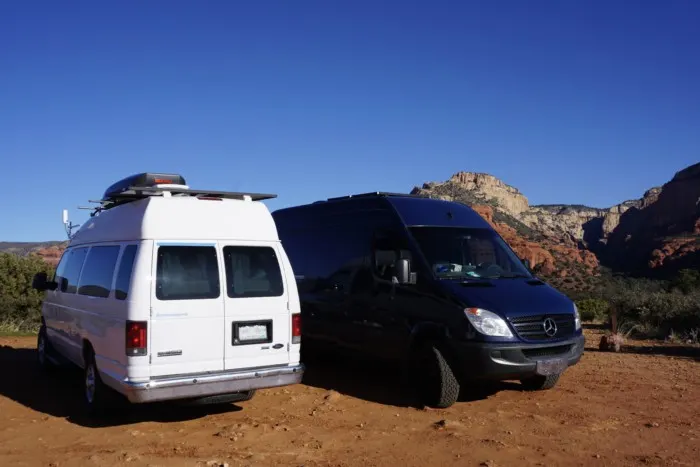
Since the Ford, Chevy, GMC, and Dodge work vans are so common in the US, these vans are quite affordable. Especially when compared to the more expensive ‘high-roof’ Mercedes Sprinter, Ford Transit, and Ram Promaster. Mercedes is just an expensive brand in general, and the Transit and Promaster just haven’t been around long enough to drop in price.
So aftermarket hightop vans are usually substantially cheaper than “sprinter-style” vans.
Standing Height
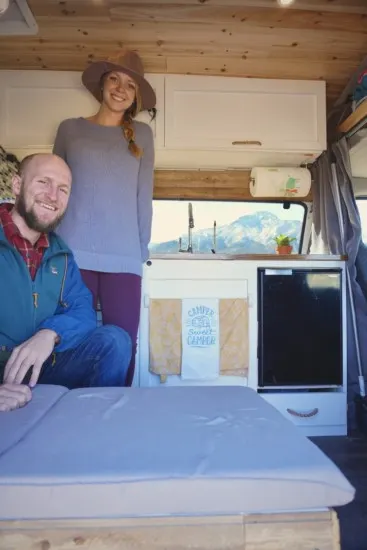
An aftermarket high-top van can sometimes provide enough room to stand inside the van. Obviously, not everyone is the same height, and, not all aftermarket fiberglass hightops are the same. They are made by lots of different companies and come in many different shapes and sizes. So the interior height of a van with an aftermarket fiberglass high-top may vary significantly.
For example, once our van was converted, the interior standing height is only 5’9”. I am 5’8” so this is really the bare minimum to qualify as standing height. But standing vs not-standing really makes all the difference for my comfort in Vanlife.
Easy To Service
American made vans are very common in the US, and they share many similarities with their pick-up truck counterparts. So most mechanics are very comfortable working on them, and parts are easy to get.
These van lineups also have been in production largely unchanged for decades, so sourcing parts yourself is sometimes an option. Emily and I went to a junkyard to find new sun visors for our van. We started checking every Ford van that we saw and eventually found good sun visors on a 2002 Econoline that fit perfectly on our 2010 Ford E-350. But this strategy can sometimes be used on something a little more substantial than sun visors, haha.
Reliable
And similarly, these work vans have been carrying the load of so many US businesses for decades. When treated well, they can easily last to 300k miles or more.
Cons Of A Fiberglass Hightop Van
Minimal Headroom
Again, not all fiberglass high-tops are the same. But generally, a “High Roof” version of the Sprinter, Transit, or Promaster will be significantly taller than an aftermarket fiberglass hightop van. If you are taller than 6 feet, then you may have trouble finding a fiberglass hightop van that is tall enough for you. This means that many tall people end up buying “sprinter-style” vans in the end.
And speaking from experience, our campervan barely gives me any head clearance. So even just wearing shoes is enough to make me hit my head sometimes. But Emily is 5’3” and it’s plenty tall for her. So it really depends on your height and the height of the high-top.
Short Doors
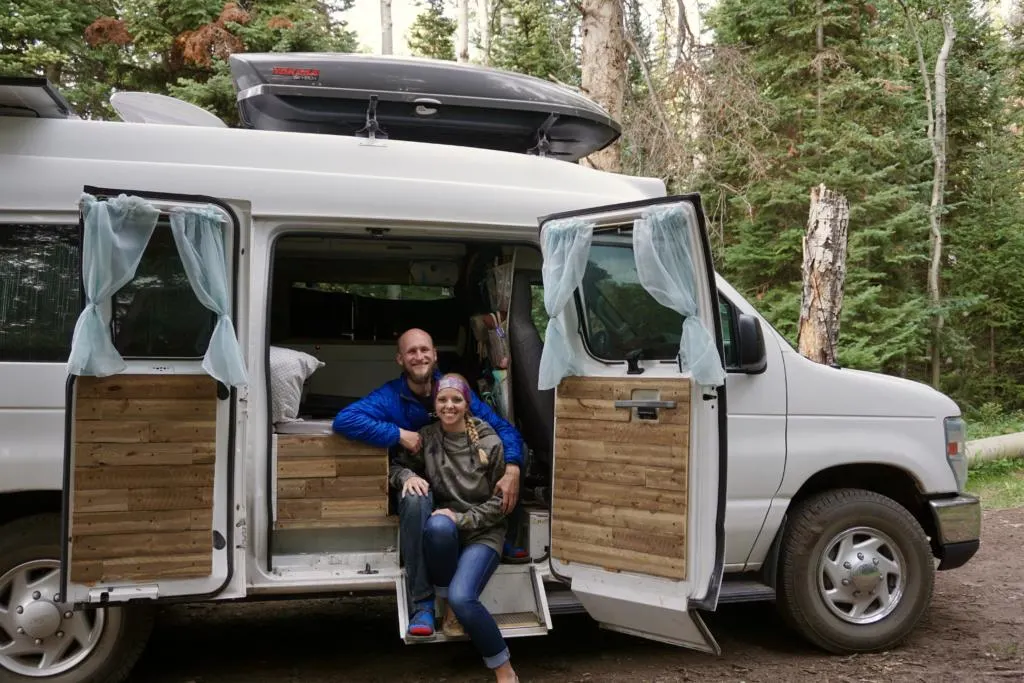
Most (but not all) aftermarket fiberglass high-tops don’t make any alterations to the doors. So while you gain extra internal height, you’re still stuck with the short doors. This means that you may have to duck when entering and exiting your campervan.
And from a photography perspective (something that I think about), it means that it’s much harder for us to take those classic #vanlife photos. Sitting on our bed and looking out the back looks more like a little slot than a great big window to the world.
It’s honestly a pretty big bummer sometimes, and next time I will be on the lookout for vans that have modified doors as well.

Extra Curves
This is one of the biggest challenges of converting a van with an aftermarket fiberglass hightop. The walls of a van are already curved, but adding in an aftermarket top means twice the curves. It can be a real headache.
They basically cut out the original metal roof and then attach the hightop over that. But what’s left behind is a very awkward transition section that can have asymmetrical lines, sharp edges, and cut into your living space.
So instead of accounting for just one slight curve from floor to ceiling (like with “sprinter-style” vans), you have to account for even more curves. This is what shape our closet had to be (annoying).
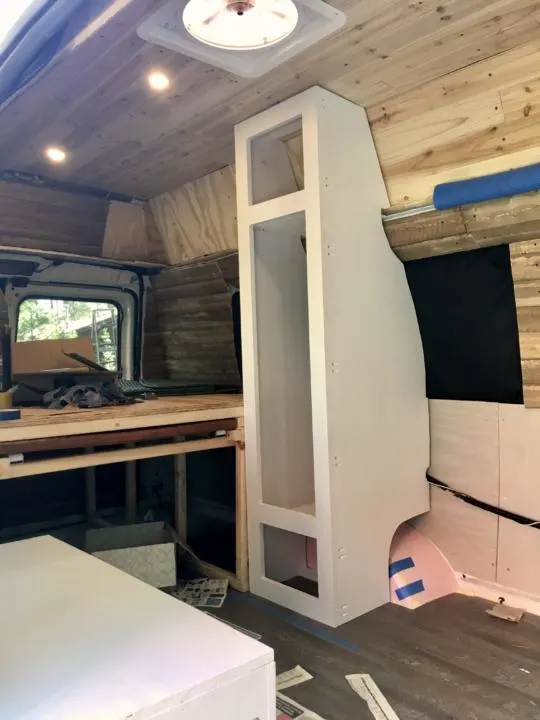
We did however find some ways to work with the shape that we had. Don’t try to force a certain layout to fit into these vans. You have to work with what the van gives you. For example, we used the “ledge” created by the old roof as a platform to support our overhead cabinets.
Narrower Roof
When compared to the “boxy” shape of Mercedes Sprinter, Ford Transit, and Ram Promaster, a fiberglass high-top van will probably have a much narrower and rounder roof. The difference may seem subtle, but I promise you, it’s not. It means that any overhead cabinets or seating areas are affected by the walls “closing in”.
When we realized this, we had to decide whether we wanted to make really small overhead cabinets that were at least out of the way. Or we could make bigger cabinets that obstruct the view of the kitchen counter. We ended up opting for more storage, and dealing with cabinets that stick out pretty far.

This problem is also apparent when sitting on our bed or bench. It requires decent pillows or cushions to extend your body away from the wall curving in.
Roof Mounting Challenges
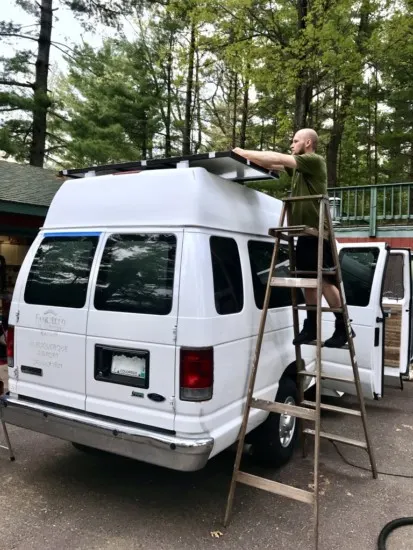
This aspect is really quite a pain. When it comes to attaching things on top of your van and to the ceiling on the inside, it can be challenging. It’s hard to figure out how to make things sturdy enough for life on the road, without just drilling straight through the roof. And again, they tend to be very curvy.
Fiberglass is usually only about ⅛” thick. So that doesn’t give you anything to attach screws to without going through the other side. Some aftermarket fiberglass hightop vans will have wooden supports that are built into the fiberglass. This is the best-case scenario because then you have something solid to drill into. Our van had four big wooden ribs that ran the length of our topper. We used these to attach horizontal “ribs” that were key to how we attached our DIY Ceder plank ceiling. And also for anchoring our overhead cabinets.
Then on the outside of the van is another story. How are you gonna mount something flat to a rounded piece of fiberglass? And how much weight can your specific aftermarket fiberglass hightop support? There’s not going to be anything in your vehicle’s manual about it, so unless you can track down the specific maker of that topper, then you are left to guessing.
This basically results in some seriously custom DIY roof mountings. We attached a Yakima cargo box to the roof of our van basically just hoping that it could support the weight. I custom bent some “T” braces in order to mount a roof rack. And our solar panel mounts were leveled with custom wooden blocks that were tediously cut and sanded to the perfect shape. After about 1.5 years on the road, nothing has come crashing down yet!
Rare
Choosing a fiberglass hightop van first means that you need to find one. They can be pretty rare and hard to search for because there isn’t one official name for these types of vans. So if you are trying to buy a used one it takes some crafty use of keywords to find them. But finding a good one can be a real jackpot.
The best things to search for, are Conversion van, Handicapped, Shuttle, Ambulance, fiberglass hightop. I have had decent luck locating these types of vans by using these keywords.
Or you can have a company like Fiberine in CA, add an aftermarket fiberglass hightop for you.
Conclusion | Why Choose A Fiberglass Higtop Van for A Campervan Conversion
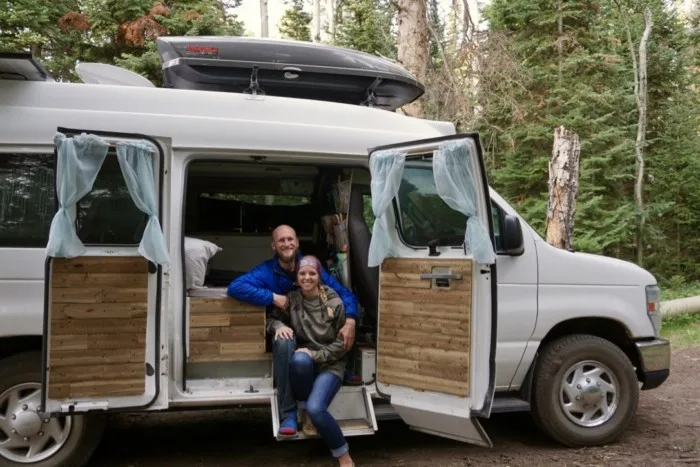
While there are definitely some challenges if you choose a fiberglass hightop van for your van conversion, the benefits can be massive. They are sometimes the most affordable option that fits people’s budget and allows them enough room to stand, which is a real game-changer for Vanlife.
In our case, we got a “standing-height” van for thousands cheaper than we would have been able to get any “sprinter-style” van with comparable mileage. So, for us, any minor negatives are outweighed by the price.
But you will have to decide for yourself if a fiberglass hightop van is a good choice for your campervan.

Check out my other post that talks about all the factors involved in How To Choose A Van For A Campervan Conversion.
Save ‘Why Choose A Fiberglass Hightop Van For A Campervan Conversion’
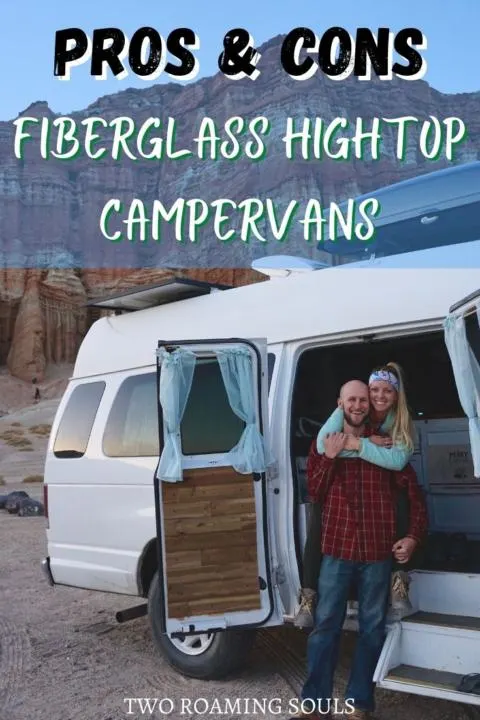


Campervan Storage Hacks | How To Maximize A Small Space - tworoamingsouls
Friday 7th of April 2023
[…] storage in your campervan. Jake and I have a Yakima Skybox that is attached to our roof rack on our fiberglass hightop. If you have a fiberglass hightop, check out our guide for how to attach a cargo box on a […]
How Much Did Our Camper Van Conversion Cost - tworoamingsouls
Monday 5th of December 2022
[…] chose a 2010 Ford E-350 Super Duty Extended XLT with an aftermarket fiberglass high top. Our gas engine is a V8, 5.4 Liter. We also have a flex fuel gas tank (which means our tank accepts […]
Best Awnings For Camper Vans To Extend Your Outdoor Living Space - tworoamingsouls
Tuesday 12th of April 2022
[…] you have a fiberglass high top or similar, there are suction cup attachments to connect the carabiners. Lastly, if you want a more […]
How To Mount Things To The Roof Of A Fiberglass Hightop Van - tworoamingsouls
Wednesday 14th of July 2021
[…] you might be curious Why To Choose A Fiberglass Hightop Van in the first […]
How To Choose A Van For A Campervan Conversion - tworoamingsouls
Thursday 18th of February 2021
[…] I’ve written a whole post about Why Choose A Fiberglass Hightop Van For A Campervan Conversion. […]